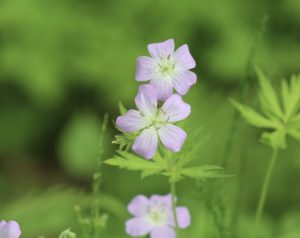As we say good-bye to the beautiful spring bulbs and brightly colored flowering shrubs, we often face a few weeks of limited color within our gardens. This time period coincides with many hungry pollinators awakening and returning to our area. While we are looking for visual beauty in our gardens, the insects are searching for food. It is not accidental that our native late spring flowers begin producing nectar just in time for the return of our native pollinators. Native plants have developed over the millennia to specifically cater to the needs of their pollinators, so timing is important.
Many of us are trying to do more research before purchasing new plants. We may be looking for plants to provide additional ecological benefits within our landscape, such as providing wildlife with food, shelter, and nesting sites. Gardeners may be interested in growing plants that do well without pesticides, require little watering and don’t spread aggressively. Native plants fulfill these requirements.
The plants listed below are native perennial plants that provide long-lasting color for our late spring gardens. Also listed is at least one additional benefit to our wildlife. As you venture into your spring planting, be aware of later emerging perennials that may be getting a slow start as they patiently wait for both soil and air temperatures to rise. It’s so easy to misstep or dig too closely to a late-emerging plant such as Black-eyed Susan (Rudbeckia hirta) or Joe-Pye weed (Eutrochium purpureum).
All accompanying pictures of these plants were taken at Tyler Arboretum. Please find a list of additional resources below, following the last picture.
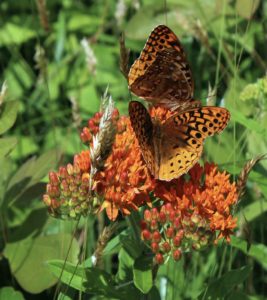
Butterfly weed (Asclepias tuberosa) features clusters of bright orange to yellow-orange flowers early June through August. This plant tolerates deer, attracts butterflies, and is a host plant for monarch caterpillars in addition to 12 other species of butterflies and moths. This plant is found in Tyler’s meadows, pictured here in June along with two fritillary butterflies.
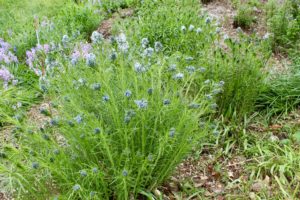
Blue star (Amsonia) features powdery blue, 1/2″ star-like flowers clustered together in late spring atop stems rising to 3′ tall. This plant tolerates rabbits and attracts butterflies. This is found near Tyler’s parking lot, along the scenic route and surrounding the cistern. Pictured here as the flowers are just beginning to open at the cistern in May.
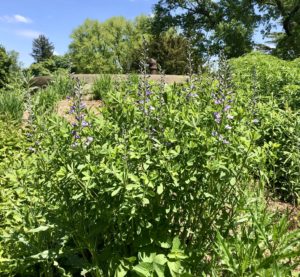
Blue false indigo (Baptisia australis) flowers May to June and features erect purple lupine-like flowers. This plant tolerates rabbits and attracts butterflies. You will find this in the plantings surrounding Tyler’s cisternand in the meadows. Pictured here at the cistern, soon to open.
Cranesbill (Geranium maculatam) flowers late April through June featuring pink to lilac, saucer shaped flowers with a diameter of 1.5”. This plant tolerates rabbits and attracts butterflies. This is found at Tyler in semi-shady areas along the scenic route, pictured here in May.
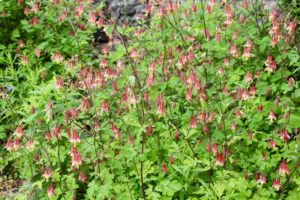 Eastern red columbine (Aquilegia canadensis) flowers late April through June featuring drooping, bell-like, 1-2″red and yellow flowers. This plant tolerates deer and rabbits, and attracts hummingbirds. You can find this plant in the barn garden as seen here in May.
Eastern red columbine (Aquilegia canadensis) flowers late April through June featuring drooping, bell-like, 1-2″red and yellow flowers. This plant tolerates deer and rabbits, and attracts hummingbirds. You can find this plant in the barn garden as seen here in May.
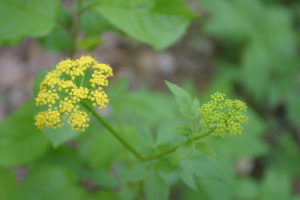 Golden Alexanders (Zizia aurea) Features flat-topped clusters of tiny yellow flowers in late spring atop stems growing to 3′ tall. Flowers May to June and attracts butterflies. This is found along the Scenic Route at Tyler as seen here in May.
Golden Alexanders (Zizia aurea) Features flat-topped clusters of tiny yellow flowers in late spring atop stems growing to 3′ tall. Flowers May to June and attracts butterflies. This is found along the Scenic Route at Tyler as seen here in May.

Golden ragwort (Packera aurea) Features flat-topped clusters (corymbs) of yellow, daisy-like flowers (to 1″ diameter) in early spring. Flowers last for weeks, April through May. This is found along the Native Woodland Walk at Tyler, and under the barn ramp. It’s pictured here in May, in the Native Woodland Walk.
Additional resources:
Ladybird Johnson Wildflower Center allows you to choose your state and add in additional filters such as bloom time and light requirements.
The Xerces Society focuses on pollinator plants, and provides additional links. This link takes you specifically to the mid-Atlantic region.
Mt. Cuba Center provides a descriptive summary along with plant pictures.


